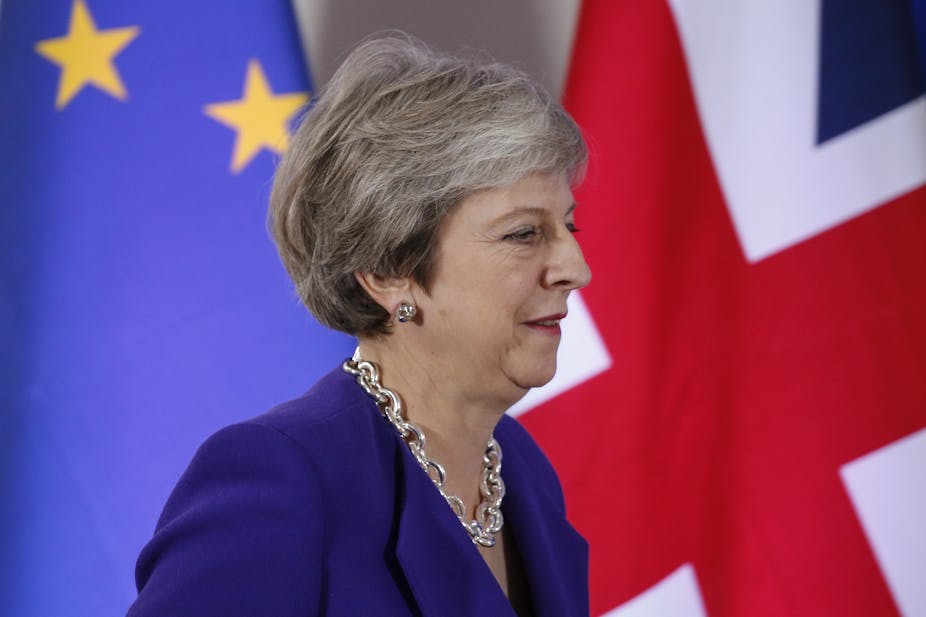The UK prime minister, Theresa May, has signalled to EU leaders that she is willing to accept a one-year extension to the proposed “transition period” that will follow the UK’s withdrawal from the EU on March 29 2019. This would mean that the UK could remain subject to EU rules and policies until December 31 2021. That would include remaining under the jurisdiction of the European Court of Justice.
The rationale for considering a longer transition period is that it would provide the UK and the EU with more time to negotiate an agreement governing their future relationship. That, in turn, would reduce (if not remove) the likelihood of having to fall back on the much-contested Northern Ireland “backstop” arrangements.
Much of the focus is on the trade elements of the backstop and the shared UK and EU commitment to avoiding a hard border on the island of Ireland. The backstop covers regulatory alignment as well, particularly regarding the free movement of goods. The shared commitments also go further, however, and include upholding the 1998 Belfast (Good Friday) Agreement and supporting north-south cooperation on the island of Ireland and the all-island economy.
Opposition to the backstop arrangements from within the UK government – and especially from the Democratic Unionist Party (DUP), on which Theresa May relies for a parliamentary majority in Westminster – is the key stumbling block on the road to concluding the withdrawal agreement with the EU.
The major concern is that the backstop arrangements – as currently drafted – would, in the absence of an agreement on a future UK-EU relationship that avoids a hard border, see Northern Ireland remain in the EU customs union and its single market, while the rest of the UK left.
A consequence of this would be additional checks and controls on the movement of goods into Northern Ireland from the rest of the UK. As the vocal reaction of the DUP in particular has shown, some see this as undermining the economic and constitutional integrity of the UK.
Breathing space
So, to avoid the backstop entering into force, the UK and the EU will need to agree and ratify the terms of a trade relationship that at least leaves the Irish border in its current state. And they need to do it before the end of the transition period.
From the point of view of providing sufficient time to negotiate and secure the ratification of an agreement on the future UK-EU relationship, a longer transition period makes good sense. Agreements providing for the level of ambition in terms of trade and cooperation to which the UK and the EU aspire take time.
Admittedly the starting point for negotiations between the UK and the EU will be one of regulatory and policy convergence. But, as the domestic UK debate on – and the EU reaction to – the UK government’s Chequer’s proposals has shown, there are major differences of opinion on what form the future relationship can and should take.

The negotiations on the Withdrawal Agreement have been fraught. With more than 18 months having passed since Article 50 was triggered, the talks have taken much longer than expected. In all likelihood, negotiations on the future UK-EU relationship will need more time than the 21 months provided by the current transition period. They are also unlikely to start in earnest immediately after March 29 2019. The EU will be preoccupied with preparations for the European Parliament elections in May 2019, which will be followed by the appointment of a new Commission, including its president.
Furthermore, it is expected that the eventual agreement on the future UK-EU relationship will need to be ratified – not just by the UK parliament and the European Parliament, but also by each of the 27 EU member states. The ratification of EU agreements often involves lengthy domestic processes lasting up to 18 months if not longer. In some member states these can also involve votes in regional parliaments and potentially a referendum.
Thinking space
Expectations that the future UK-EU relationship could be negotiated and approved within 18 months of the UK’s withdrawal are unrealistic. Having the option of extending the transition period therefore makes sense.
But rational thinking is not always what determines the content and direction of domestic UK debate on Brexit. Politics matters. And an extension to the transition period clearly has its opponents. Some quite rightly argue it would extend the period in which the UK would be subject to many of the obligations of EU membership without having a say in any decisions. A longer transition would, for them, simply extend the period of “Brexit in name only”.
Moreover, it is far from certain that a future UK-EU agreement – and especially the post-transition trading relationship – will negate the need for all or some of the Northern Ireland backstop arrangements to come into force, particularly if the UK is outside the EU customs union. An extended transition period may not deliver.
The advantage of an extended transition, however, is that it does provide a more realistic timeframe for reaching agreement on UK-wide arrangements with the EU that ensure no hard border on the island of Ireland. Also, pending an agreement, it creates space for a more measured assessment of what the implementation of the backstop arrangements would mean for Northern Ireland and its position in the United Kingdom.
More immediately, an extension provides May with an opportunity to reassure her backbench opponents and the DUP that an agreement with the EU can more realistically be put in place during the transition period such that the backstop arrangements will never have to be implemented.
If her opponents trust May, the extension could help nudge the withdrawal negotiations closer to a deal. It is a big “if”.

